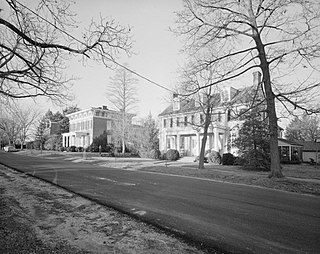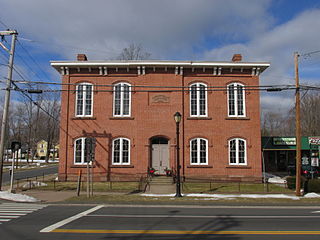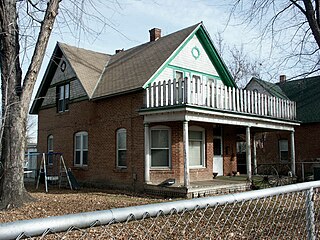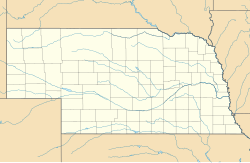
This is intended to be a complete list of properties and districts listed on the National Register of Historic Places in Orleans County, New York. The locations of National Register properties and districts may be seen in a map by clicking on "Map of all coordinates". Two listings, the New York State Barge Canal and the Cobblestone Historic District, are further designated a National Historic Landmark.
The Seth Lore and Irwinton Historic District is a historic district in Eufaula, Barbour County, Alabama, United States. It was listed on the National Register of Historic Places in 1973 as Lore Historic District; the registration document identified and described 72 specific buildings. And then its boundaries were increased and the district was renamed to "Seth Lore and Irwinton Historic District" in 1986; the entire area then contained 738 contributing buildings.

Odessa Historic District is a national historic district located at Odessa, New Castle County, Delaware. It encompasses 82 contributing buildings in the central business district and surrounding residential areas in the shipping and trading center of Odessa. It includes a mix of commercial and residential buildings primarily dating to the 18th and 19th century. The oldest building is the Collins-Sharp House. Other notable buildings include the Judge Lore House, Brick Hotel (1822), the Davis Store (1824), Cyrus Polk House (1853), Zoar ME Church (1881), Wilson-Warner House, Academy building (1844), Red Men Lodge (1894), and Old St. Paul's Methodist Episcopal parsonage. Also located in the district and separately listed are the Appoquinimink Friends Meetinghouse, Corbit-Sharp House, and Old St. Paul's Methodist Episcopal Church.

Natchez On-Top-of-the-Hill Historic District is a historic district in Natchez, Mississippi that was listed on the National Register of Historic Places in 1979.

The Hazardville Historic District is a historic district in the Hazardville section of Enfield, Connecticut, United States, that is listed on the National Register of Historic Places.
The National Register of Historic Places listings in Syracuse, New York are described below. There are 120 listed properties and districts in the city of Syracuse, including 19 business or public buildings, 13 historic districts, 6 churches, four school or university buildings, three parks, six apartment buildings, and 43 houses. Twenty-nine of the listed houses were designed by architect Ward Wellington Ward; 25 of these were listed as a group in 1996.

Sylvester Commercial Historic District is a historic district in Sylvester, Georgia that was listed on the National Register of Historic Places (NRHP) in 1987. It includes the Worth County Local Building which is separately NRHP-listed. Its boundaries were increased in 2002 to include some federally owned property. The expanded district included 65 contributing buildings and 16 noncontributing buildings.
Upper–Mill Street Historic District is a national historic district located at Poughkeepsie, Dutchess County, New York. It includes 25 contributing buildings built during the mid- to late-19th century. They include a variety of brick and frame buildings, originally residential, that have been converted to office and other commercial use. They are representative of vernacular mill workers' dwellings and fashionable factory owners' residences. The district also includes two churches.

Linden–South Historic District is a national historic district located in the South Wedge neighborhood of Rochester in Monroe County, New York. The district consists of 136 contributing buildings, including 82 residential buildings, 53 outbuildings, and one church. The houses were constructed between 1872 and 1913 in a variety of vernacular interpretations of popular architectural styles including Gothic Revival, Italianate, Queen Anne, and Colonial Revival styles. The houses are 2 1/2-stories, are of frame or brick construction, and were designed by local architects employed by the developer Ellwanger & Barry. Among the more prominent are Andrew Jackson Warner and Claude Bragdon. The church is the former South Avenue Baptist Church, now Holy Spirit Greek Orthodox Church, built in 1909–1910 in a Late Gothic Revival style. Also in the district is a three-story, Queen Anne style mixed use building, with commercial space on the first floor and residential units above, located at 785 South Avenue.

St. Benedict's Catholic Church is a Catholic church in Nebraska City, Nebraska, United States. It is on the National Register of Historic Places. The church parish was founded in 1856 and its building, completed in 1861, is the oldest brick church in the state of Nebraska. The church's address is 411 5th Rue, Nebraska City, Nebraska.

The Bank Street–Old Decatur Historic District is a historic district in Decatur, Alabama. The district encompasses the original commercial and residential portion of Decatur along the Tennessee River. In 1832, Decatur was selected over the larger Huntsville as the site of the northern branch of the state bank. Bank Street became the commercial hub of the town, as it was the only place in the Tennessee Valley were riverboat, wagon, and rail transportation converged. Due to its strategic location, the town suffered heavy damage in the Civil War; the Todd House on Lafayette Street is one of only four buildings in Decatur to survive the war. As the town was rebuilding from the war, a fire in 1877 destroyed most of the buildings along Bank Street. The rebuilt structures were all of brick, and represent Italianate, Victorian, and Commercial styles popular from the late 19th to the early 20th centuries. Houses in the district are primarily modest, and styles include vernacular Victorian, Shingle-style, and Craftsman bungalows.

The Bethesda Baptist Church and Cemetery in Greene County, Georgia near Union Point, Georgia was built in 1818. It was listed on the National Register of Historic Places in 1998. The listing included two contributing buildings, two contributing structures, and two contributing sites.

The Beattystown Historic District is a 35-acre (14 ha) historic district in the village of Beattystown in Mansfield Township of Warren County, New Jersey, United States. The district was added to the National Register of Historic Places on September 28, 1990 for its significance in architecture, commerce, industry, and settlement pattern from 1762 to 1929. It includes 32 contributing buildings.

The Elizabethtown Courthouse Square and Commercial District, in Elizabethtown, Kentucky, is a 10 acres (4.0 ha) historic district which was listed on the National Register of Historic Places in 1980. The listing included 38 contributing buildings.

The Church Avenue-Lovers Lane Historic District in Aztec, New Mexico was listed on the National Register of Historic Places in 1985. It is a 16 acres (6.5 ha) mainly residential historic district bounded by Rio Grande E., Zia S., Park W. and New Mexico Highway 550. The listing included 38 contributing buildings and a contributing structure.

The Avondale Historic District in Alexander City, Alabama, is a 750 acres (3.0 km2) historic district which was listed on the National Register of Historic Places in 2005.

Bartow Historic District, in Bartow, Georgia is a historic district which was listed on the National Register of Historic Places. The district included 121 contributing buildings, three contributing structures, and a contributing site. Its 209 acres (85 ha) area is roughly centered along Church St., Wadley Road and the CSX rail line.

The Morristown District, also known as the Morristown Historic District, is a historic district in the town of Morristown in Morris County, New Jersey. It was added to the National Register of Historic Places on October 30, 1973, for its significance in architecture, communications, education, military, politics, religion, social history, and transportation.

The Downtown Paris Historic District, in Paris, Kentucky, in Bourbon County, Kentucky, is a historic district which was listed on the National Register of Historic Places in 1989.



















